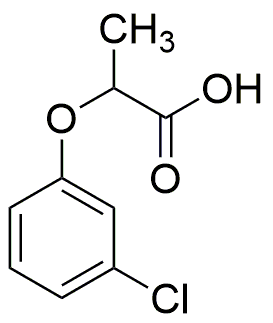2-(3-Chlorophenoxy)propionic acid is widely utilized in research focused on
- Agriculture: This compound serves as a herbicide, effectively controlling a variety of broadleaf weeds in crops, which helps farmers increase yield and reduce competition for nutrients.
- Pharmaceuticals: It is used in the synthesis of various pharmaceutical agents, contributing to the development of medications that target specific biological pathways.
- Research and Development: In laboratories, it acts as a valuable reagent for studying biochemical processes, allowing researchers to explore its effects on plant growth and metabolism.
- Environmental Science: The compound is utilized in studies assessing the impact of herbicides on ecosystems, helping scientists understand and mitigate environmental risks associated with agricultural practices.
- Chemical Manufacturing: It plays a role in the production of specialty chemicals, where its unique properties can enhance the performance of various formulations.
General Information
Properties
Safety and Regulations
Applications
2-(3-Chlorophenoxy)propionic acid is widely utilized in research focused on
- Agriculture: This compound serves as a herbicide, effectively controlling a variety of broadleaf weeds in crops, which helps farmers increase yield and reduce competition for nutrients.
- Pharmaceuticals: It is used in the synthesis of various pharmaceutical agents, contributing to the development of medications that target specific biological pathways.
- Research and Development: In laboratories, it acts as a valuable reagent for studying biochemical processes, allowing researchers to explore its effects on plant growth and metabolism.
- Environmental Science: The compound is utilized in studies assessing the impact of herbicides on ecosystems, helping scientists understand and mitigate environmental risks associated with agricultural practices.
- Chemical Manufacturing: It plays a role in the production of specialty chemicals, where its unique properties can enhance the performance of various formulations.
Documents
Safety Data Sheets (SDS)
The SDS provides comprehensive safety information on handling, storage, and disposal of the product.
Product Specification (PS)
The PS provides a comprehensive breakdown of the product’s properties, including chemical composition, physical state, purity, and storage requirements. It also details acceptable quality ranges and the product's intended applications.
Certificates of Analysis (COA)
Search for Certificates of Analysis (COA) by entering the products Lot Number. Lot and Batch Numbers can be found on a product’s label following the words ‘Lot’ or ‘Batch’.
*Catalog Number
*Lot Number
Certificates Of Origin (COO)
This COO confirms the country where the product was manufactured, and also details the materials and components used in it and whether it is derived from natural, synthetic, or other specific sources. This certificate may be required for customs, trade, and regulatory compliance.
*Catalog Number
*Lot Number
Safety Data Sheets (SDS)
The SDS provides comprehensive safety information on handling, storage, and disposal of the product.
DownloadProduct Specification (PS)
The PS provides a comprehensive breakdown of the product’s properties, including chemical composition, physical state, purity, and storage requirements. It also details acceptable quality ranges and the product's intended applications.
DownloadCertificates of Analysis (COA)
Search for Certificates of Analysis (COA) by entering the products Lot Number. Lot and Batch Numbers can be found on a product’s label following the words ‘Lot’ or ‘Batch’.
*Catalog Number
*Lot Number
Certificates Of Origin (COO)
This COO confirms the country where the product was manufactured, and also details the materials and components used in it and whether it is derived from natural, synthetic, or other specific sources. This certificate may be required for customs, trade, and regulatory compliance.


